#Gazan
Text
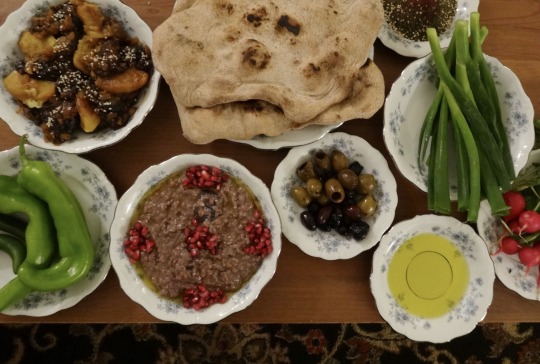

[ID: A purplish-grey stew topped with olive oil and garnished with piles of pomegranate seeds. Plates of green peppers, bitter olives, olive oil, taboon bread, green onions, radishes, and za'tar surround the dish. The second image is a close-up of the same stew. End ID]
رمانية / Rummāniyya (Palestinian pomegranate stew)
Rummaniyya (رُمَّانِيَّة; also transliterated "rumaniyya," "rummaniya," and "rummaniyeh") is a Palestinian stew or dip made from lentils, eggplant, and pomegranate seeds, flavored with nutty red tahina and a zesty, spicy دُقَّة (dugga) of dill seeds, garlic, and peppers. A طشة (ṭsha), or tempering, of olive oil and onion or garlic is sometimes added.
"Rummaniyya," roughly "pomegranate-y," comes from رُمَّان ("rummān") "pomegranate," plus the abstract noun suffix ـِيَّة ("iyya"); the dish is also known as حبّة رُمَّانَة ("ḥabbat rommāna"), or "pomegranate seeds." It is a seasonal dish that is made at the end of summer and the beginning of fall, when pomegranates are still green, unripe, and sour.
This stew is considered to be one of the most iconic, historic, and beloved of Palestinian dishes by people from Gaza, Yaffa, and Al-Ludd. Pomegranates—their seeds, their juice, and a thick syrup made from reducing the juice down—are integral to Palestinian cuisine and heritage, and images of them abound on ceramics and textiles. Pomegranates and their juice are sold from street carts and cafes in the West Bank and Gaza.
Today, tens of thousands of tons of pomegranates are grown and harvested by Israeli farmers on stolen Palestinian farmland; about half of the crop is exported, mainly to Europe. Meanwhile, Palestinians have a far easier time gaining permits to work on Israeli-owned farms than getting permission from the military to work land that is ostensibly theirs. These restrictions apply within several kilometers of Israel's claimed borders with Gaza and the West Bank, some of the most fertile land in the area; Palestinian farmers working in this zone risk being injured or killed by military fire.
Israel further restricts Palestinians' ability to work their farms and export crops by imposing tariffs, unexpectedly closing borders, shutting down and contaminating water supplies, spraying Palestinian crops with pesticides, bulldozing crops (including eggplant) when they are ready to be harvested, and bombing Palestinian farmland and generators. Though Palestinian goods have local markets, the sale of Palestinian crops to Israel was forbidden from 2007 to 2014 (when Israel accepted shipments of goods including tomato and eggplant).
Gazans have resisted these methods by disregarding orders to avoid the arable land near Israel's claimed borders, continuing to forage native plants, growing new spices and herbs for export, planting hydroponic rooftop gardens, crushing chalk and dried eggplants to produce calcium for plants, using fish excrement as fertilizer, creating water purification systems, and growing plants in saltwater. Resisting Israeli targeting of Palestinian food self-sufficiency has been necessary for practical and economic reasons, but also symbolizes the endurance of Palestinian culture, history, and identity.
Support Palestinian resistance by calling Elbit System's (Israel's primary weapons manufacturer) landlord; donating to Palestine Action's bail fund; and buying an e-Sim for distribution in Gaza.
Serves 6-8.
Ingredients:
For the stew:
1 medium eggplant (370g)
1 cup brown lentils (عدس اسود)
600g pomegranate seeds (to make 3 cups juice)
3 Tbsp all-purpose flour
1/4 cup red tahina
1/2 cup olive oil
Salt, to taste
Citric acid (ملح الليمون / حامِض ليمون) (optional)
Red tahina may be approximated with home cooking tools with the above-linked recipe; you may also toast white tahina in a skillet with a little olive oil, stirring often, until it becomes deeply golden brown.
For the دُقَّة (dugga / crushed condiment):
2 tsp cumin seeds, or ground cumin
1 1/2 Tbsp dill seeds ("locust eye" بذور الشبت / عين جرادة)
5 cloves garlic
1 green sweet pepper (فلفل بارد اخضر)
2 dried red chilis (فلفل شطة احمر)
People use red and green sweet and chili peppers in whatever combination they have on hand for this recipe; e.g. red and green chilis, just green chilis, just red chilis, or just green sweet peppers. Green sweet peppers and red chilis are the most common combination.
For the طشة (Tsha / tempering) (optional):
Olive oil
1 Tbsp minced garlic
Instructions:
1. Rinse and pick over lentils. In a large pot, simmer lentils, covered, in enough water to cover for about 8 minutes, or until half-tender.
2. Meanwhile, make the dugga by combining all ingredients in a mortar and pestle or food processor, and grinding until a coarse mixture forms.

Dugga and components.
3. Cube eggplant. A medium-sized eggplant may be cut in half lengthwise (through the root), each half cut into thirds lengthwise, then cubed widthwise.


Cubed eggplant, red tahina, and pomegranate seeds.
4. Add eggplant to simmering water (there is no need to stir).
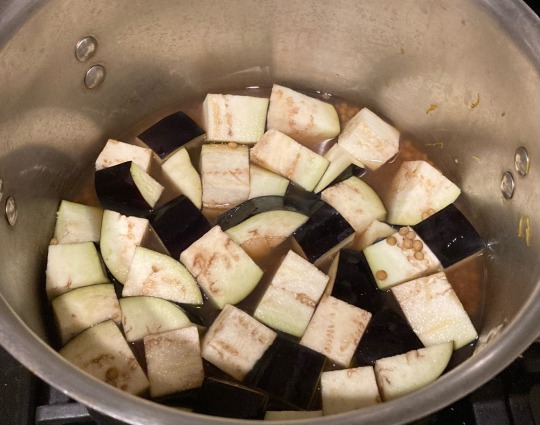
5. While the eggplant cooks, blend pomegranate seeds in a blender very thoroughly. Strain to remove any gritty residue. Whisk flour into pomegranate juice.

Pomegranate juice being strained.
6. Taste your pomegranate juice. If it is not sour, add a pinch of citric acid or a splash of lemon juice and stir.
7. Add dagga to the pot with the lentils and eggplant and stir. Continue to simmer until the eggplant is very tender and falling apart.
8. Add pomegranate juice, tahina, and olive oil to the pot, and simmer for another 5 minutes, or until stew is very thick and homogenous.

Bright pink pomegranate juice in stockpot.
9. (Optional) In a small skillet, heat a little olive oil on medium. Fry minced garlic, stirring constantly, until golden brown. Add into the pot and stir.
10. (Optional) Mash the stew with the bowl of a ladle or a bean masher to produce a more homogenous texture.
Serve rummaniyya hot or cold in individual serving bowls. It may be served as an appetizer, or as a main dish alongside flatbread, olives, and fresh vegetables such as radishes, green peppers, green onions, carrots, and romaine lettuce. It may be eaten with a spoon, or by using كماج (kmāj), a flatbread with an internal pocket, to scoop up each bite.
559 notes
·
View notes
Text


The Intercept conducted a study of 1,100 news articles on Gaza from The New York Times, the Washington Post, and the Los Angeles Times. It found that only 2 (TWO!) articles mentioned the word "children" when referring to Gazan children. You can read the full study on their website.
81 notes
·
View notes
Text
One of the released Israeli kidnapped kids, who was held for almost 50 days in the attic of a house, says he was held by an UNRWA teacher.
This teacher is a father of 10 children, who locked the hostage in the attic, didn’t provided him with any food or his medicine.
Another hostage was held captive by a a Gazan DOCTOR who continued to provide care to children in the hospital, but not the Israeli kid.
Teachers, Doctors, UNWRA staff, they're all under Hamas' control. They were there at the massacre on October 7th, and took part in holding hundreds of hostages, including women and children, captive.
Source: Israeli channel 12
#Israel 12#Israel channel 12#secular-jew#israel#jewish#judaism#israeli#jerusalem#diaspora#secular jew#secularjew#islam#Hamas#hamas is isis#10 7 23#Gaza#Gazan#hostages#antisemitism#Islamism#kibbutz#tel aviv#kidnapping
68 notes
·
View notes
Text

Gazan vs Bolin. Legend of Korra Zine
71 notes
·
View notes
Text
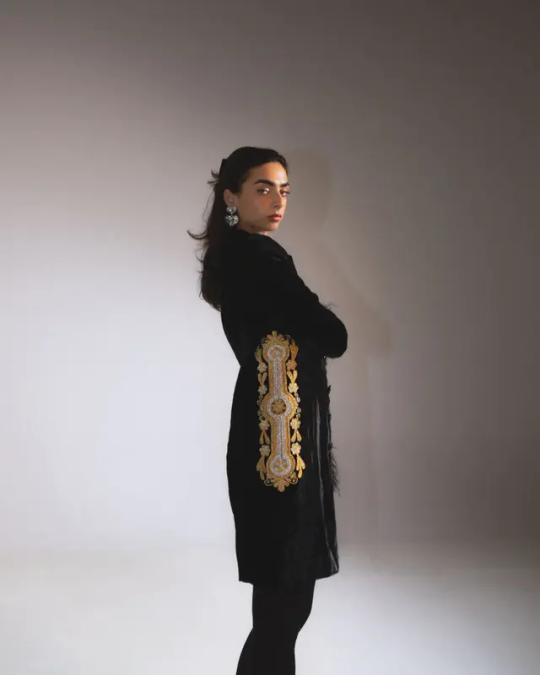

"Golden Hour Blazer Dress"
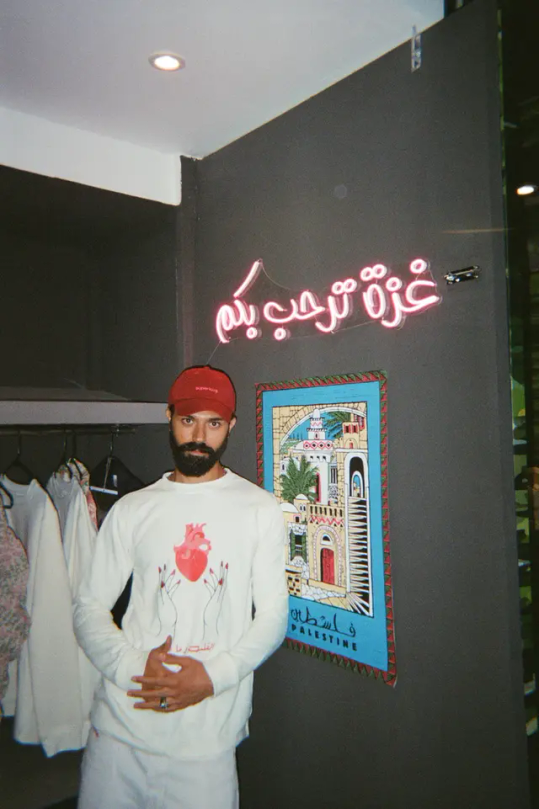
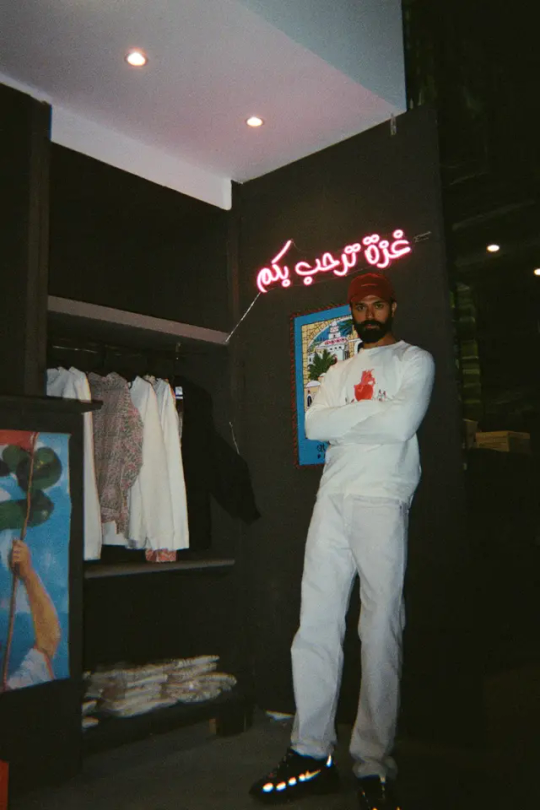
"Heart Affairs Sweatshirt"


"Navy Trouser"
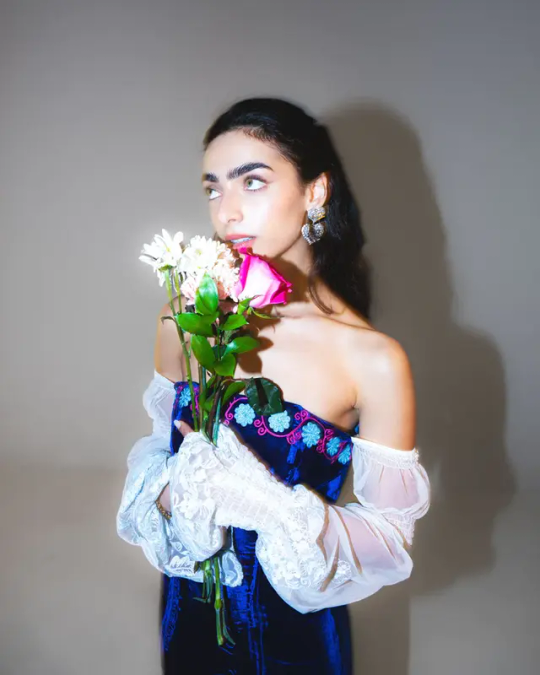

"Royalty Midi Dress"


"Ocean Reef Blazer"


"Ocean Reef Trouser"
* Some of my favorite clothes from Meera Adnan
Her business operates in Gaza and is high-end.
#palestinian#palestine#21th c. palestine#palestinian culture#palestinian art#from the river to the sea palestine will be free#gaza#gazan#free gaza#gaza strip#free palestine#fashion#modern fashion#dresses#contemporary design#contemporary fashion#21th century#21th century art#arab#middle east#middle eastern#central asia#high end#luxury#high end fashion#style#ethnic fashion
7 notes
·
View notes
Text
Graphic design artist Moataz Abu Sakran/ @moatazart has provided extensive documentation of the genocide against Gaza. His photos and videos have been used—often without credit—by major media outlets, and his posts are featured on this blog regularly.
Moataz and his wife and baby girl are trapped in the vicinity of Al-Shifa Hospital complex. The area has was under complete siege for 13 days, and made life even more difficult and dangerous than before. In addition to the physical violence of the siege, the occupation’s famine has made food extremely scarce—Moataz and Mariam can no longer find milk and nutritious food for baby Maria.
They were able to raise enough funds to begin the paperwork involved in evacuating to Egypt, but exorbitant processing fees have totally depleted the money they had reserved to find a place to stay in Egypt. They need funds to procure food and shelter while they rebuild their lives in Egypt (God willing), otherwise they will be homeless and destitute.
There was an increase in donations after we initially shared the link on this blog. We are hoping that will happen again. Please support Moataz’s family via this link so that they can reach safety. Even just a few dollars will help. If you can’t donate, please share the link on all your social media accounts.
This is the primary link to donate and share. You can copy and paste it onto other posts and social media sites.
If the primary link does not work, try this link
#north gaza#gaza#gaza genocide#gaza strip#gaza under attack#free gaza#from the river to the sea palestine will be free#palestinian genocide#gazan genocide#gaza under genocide#gaza under bombardment#gaza under fire#gaza under siege#north gaza famine#save north gaza#north gaza is starving#feed north gaza#aid for north gaza#aid for gaza#moataz abu sakran#al shifa hospital#end israel's genocide#stop gaza genocide#stop genocide#stop the genocide#stop israel#27 march 2024#فلسطين#غزة#actions
10K notes
·
View notes
Text
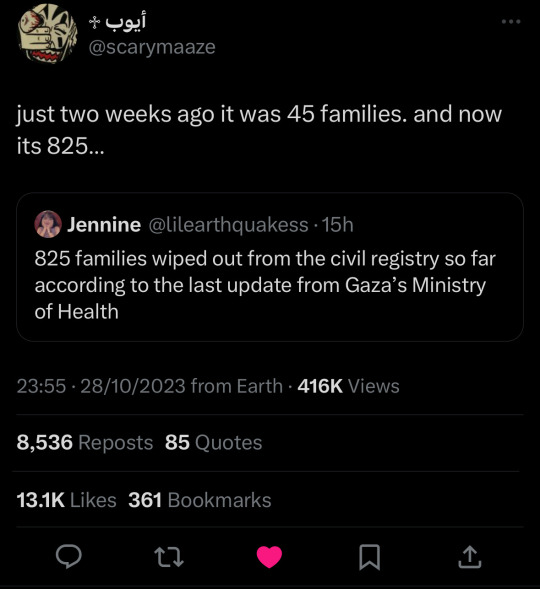
each family has at least 30 people.. entire bloodlines erased. fuck this shit, Palestine will be free and Palestinians will return to their rightful land. 🇵🇸
#stand with palestine#save palestine#palestine#free palestine#free gaza#gazaunderfire#stand with gaza#pray for gaza#every gazan has now been visited by grief and destruction#news on gaza#gazagenocide#gaza strip#gazaunderattack#save gaza#gaza
10K notes
·
View notes
Text

Palestinians enjoy their day on a beach in Gaza, March 2023 | Fatima Shbair © AP Photos
#gaza beach will always belong to gazans no matter how many flags the zionist theives spread#fatima shbair#ph#gaza#palestine#free gaza#free palestine#from the river to the sea palestine will be free#we stand with palestine#we stand with gaza
6K notes
·
View notes
Text
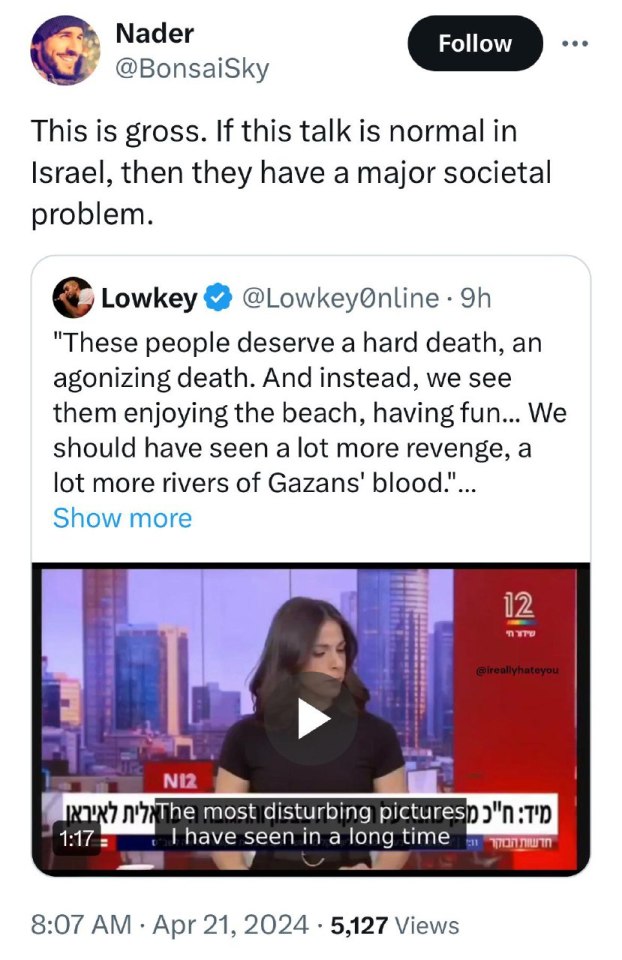
The most viewed channel in Israel says the genocide is not enough, they want to see rivers of Gazan’s blood
#The most viewed channel in Israel says the genocide is not enough#they want to see rivers of Gazan’s blood#israhell#israel#free palestine#palestine#freepalastine🇵🇸#gazaunderattack#gaza genocide#gaza strip#free gaza#gaza#fuck netanyahu#benjamin netanyahu#netanyahu a criminal of war#bibi netanyahu#anti netanyahu#no pride in genocide#genocide#class war#zionazis#zionistterror#jewish antizionism#anti israel#boycott israel#ausgov#politas#auspol#tasgov#taspol
3K notes
·
View notes
Text

[ID: A greyish brown stew presented alongside flatbread, red pepper paste, green peppers, and carrot sticks. End ID]
سماقية / Summagiyya (Gazan stew with chard, chickpea, sumac, and 'lamb')
Summagiyya (سُمَّاقِيَّة; also translitered "sumagiyya", "sumaghiyyeh" or "sumaqiyya") is one of the signature dishes of the Gaza strip, in particular Gaza City. It consists of lamb, chard, and chickpeas in a sumac-infused broth; savor and zest is added by a dagga of dill seeds, garlic, and peppers, and nutty depth by a generous drizzle of red tahina. The resulting stew is thick, earthy, and slodgily grey (due to the green chard and red sumac)—it also has the characteristic sourness of much Gazan cuisine.
Summagiyya is most often prepared during holidays, especially Eid al-Fitr; it's an excellent make-ahead dish for these occasions, since it's even better once its flavors have had time to meld and mellow overnight. It is served cold alongside fresh vegetables, and eaten by using flatbread to scoop up each bite. This recipe provides a spiced seitan recipe to replace the lamb, but you may also use any lamb or beef substitute of your choice.
Today, summagiyya is often prepared with Israeli white tahina, as decades of punitive import laws, taxes, and restrictions have enforced Palestine's status as a consumer, rather than an producer, of food products. Israeli tariffs on, and confiscations of, Palestinian goods have forced those tahina factories that survived to import sesame seeds rather than using locally grown crops, even as they export the best of their product to Israel. The dubbing of foods such as tahina and hummus as culturally "Israeli" cuisine works to hide this exploitative relationship, and cement an Israeli national identity through the subsuming and erasure of Palestinian existence. It is for this reason that Emad Moussa writes that Palestinian cuisine has a role in "protecting against a people's very extinction."
Medical Aid for Palestinians (MAP) has put out an urgent call for donations to provide medical supplies to Palestinian hospitals when supply lines reopen. Also contact your representatives in the USA, UK, and Canada.
Ingredients:
For the soup:
500g (2 large bunches) chard (شلق), diced
80g Levantine sumac berries (Rhus coriaria)
1/2 cup soaked and boiled chickpeas, mostly cooked (40g dry / scant 1/4 cup)
1/4 cup red tahina
1/2 cup (60g) all-purpose flour
1 large yellow onion
1/4 cup olive oil
1 tsp kosher salt
2 cardamom pods (optional)
2 allspice berries (optional)
More olive oil, to fry
Sumac berries can be found in the spice section of a halal grocery store. If you're unable to locate whole berries, pre-ground will do.
For the dagga:
1 1/2 Tbsp dill seeds
5 cloves garlic
1/2 green cubanelle pepper
2-3 dried red chilis (optional)
1/2 tsp black pepper
1/4 tsp cumin
Dill seeds may be found at a halal, south Asian, or speciality European grocery store. They are commonly used in Indian food and as a pickling spice. At a south Asian grocery store they may be labelled soyo, suva, shepu, or savaa.
For the lamb:
1 cup (120g) vital wheat gluten, aka gluten flour
1/2 Tbsp ground sumac
1/2 tsp ground caraway
1 tsp onion powder
1 tsp Palestinian 7-spice
1/2 tsp garlic powder
1/2 tsp sea salt
1/2 tsp ground black pepper
1/2 tsp ground cumin
1/2 tsp ground aniseed
1/2 tsp turnermic
1 tbsp olive oil
1/2 tsp soy sauce
1 tsp miso paste
2 cloves garlic, grated
2 tsp pomegranate molasses
1 Tbsp white or red tahina
About 1/2 cup vegetarian 'beef' stock from concentrate, or vegetable stock
Pomegranate molasses is simply pomegranate juice that has been reduced to a thick consistency. It may be found in the sauces section of a halal grocery store.
Instructions:
For the soup:
1. Soak dried chickpeas in cool water overnight, or in just-boiled water for an hour. Drain and re-cover with water, and boil for 30-45 minutes, until almost fully cooked. Drain and set aside.
2. Simmer sumac seeds in enough water to cover by a couple inches for about an hour, until the water is dark red. Blend the seeds and water together, then strain the mixture through a cheesecloth.
If you're using ground sumac, skip the blending step. Use a cheesecloth or very fine metal sieve (such as one intended for brewing tea) to remove the ground spice from the water.
3. Whisk the flour into the sumac-infused water.
For the lamb:
1. Combine all dry ingredients in a large mixing bowl. Add wet ingredients other than stock and stir briefly. Add enough stock to produce a soft, smooth dough.
2. Knead by hand on a clean surface, or put in a stand mixer with paddle attachment on medium-low, for about 5 minutes. You should see stringy strands begin to form in the dough.
3. Allow to rest, covered, for 5-10 minutes to encourage gluten formation. Knead for another 3 minutes. Do not over-knead.
4. Tear the dough into bite-sized pieces.
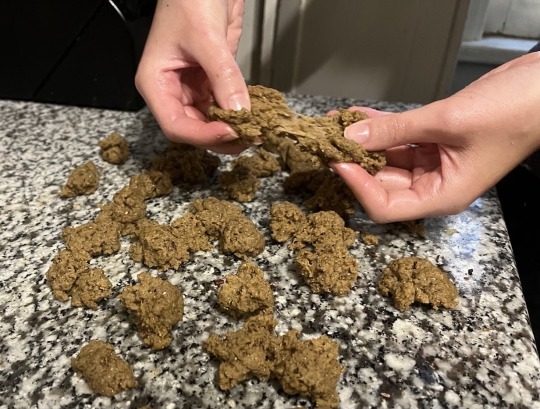
Stringy seitan being pulled apart into pieces.
You may also shape the dough into a slab and cube it with a sharp knife—the lamb or beef used in summagiyya is usually cubed—but I prefer the texture of torn seitan to sliced.
5. Steam the seitan pieces for 10 minutes in a bamboo steamer or using a metal steamer basket. Place the bamboo steamer in the bottom of a wok and cover its base by about 1/2" (1 cm), then raise the heat to boil the water; lower the heat to keep the water at a simmer. If using a steamer basket, place it over the opening of a pot containing a couple inches of water and bring it to a simmer. Start the timer when the water begins simmering.
6. Heat olive oil on medium-high and sear the steamed seitan pieces, turning as necessary, until deeply browned on all sides. Set aside.

Fried seitan pieces.
You can save a step here by searing the raw seitan, then returning it to the pot after you've fried the onions to simmer it rather than steaming. I found that this produced a mushier texture.
For the dagga (دقة):
1. Grind cumin and black pepper thoroughly in a mortar and pestle, then add dried red pepper and dill seed and crush coarsely. Add green sweet pepper and garlic and pound until a coarse mixture forms.
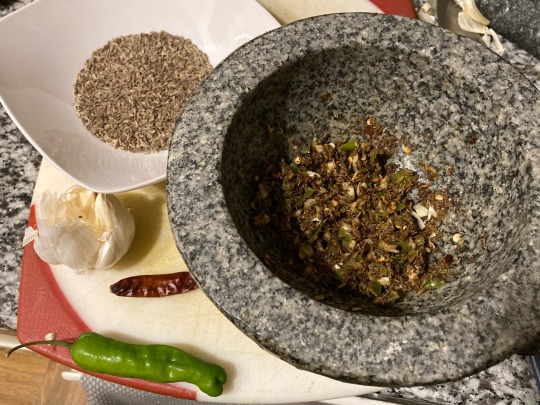
Dill seeds, green sweet pepper, garlic, and dried red chili on a cutting board, alongside dagga in a large granite mortar.
You may also use a spice mill or food processor.
To assemble:
1. Chop the onion. Wash the chard and slice it thinly in one direction; turn it ninety degrees and slice thinly again.
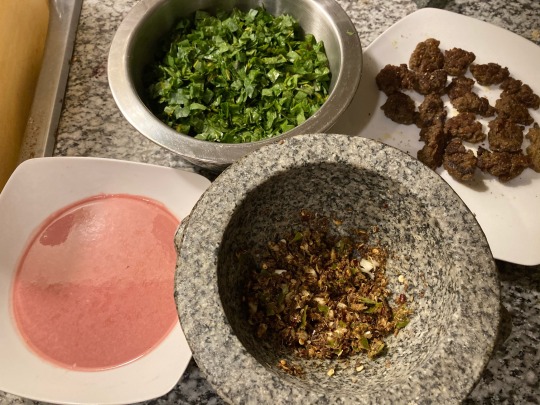
Diced chard, fried seitan, dagga, and sumac-infused water with flour.
2. In a large pot, heat a couple tablespoons of olive oil on medium. Fry chopped onion, cardamom pods, and allspice berries for a minute until fragrant. Add half of the dagga and fry until fragrant.
3. Add chard and fry, mixing often, until wilted.
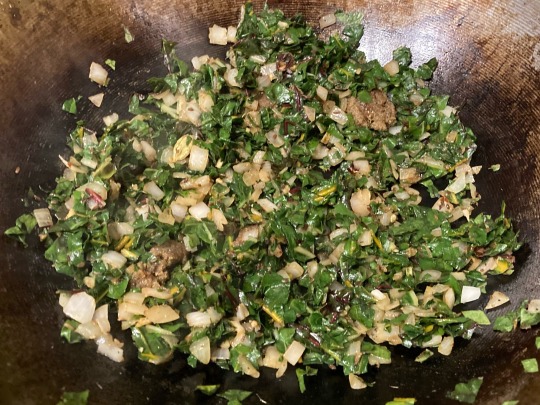
Wilted chard in a wok.
4. Add sumac mixture, chickpeas, and water to cover. Bring to a boil, then lower heat to a simmer. If you didn't steam your seitan earlier, add it now.
5. Continue to stir and simmer until the stew is thick, homogenous, and greyish-brown, about 15 minutes.

Simmered stew.
6. Add the remainder of the garlic mixture, the red tahina, a pinch of ground cumin, the 1/4 cup olive oil, and salt to taste. Return the steamed and seared seitan to the pot and mix.
Serve cool with flatbread, sweet green peppers, bitter green and black olives, carrots, leafy greens, and/or pickles.
#vegetarian recipes#vegan recipe#vegan cooking#Palestinian#Gazan#chickpeas#lamb#seitan#chard#dill seeds#pomegranate molasses
475 notes
·
View notes
Text
Feel free to reblog and add more sources of Gazan families and individuals who could use the help.
Families In Gaza Who Need Your Help:
#free palestine#gaza#palestine#free gaza#from the river to the sea palestine will be free#pray for palestine#helpgazachildren#help gaza#donation#donate#gofundme#humanitarian crisis#genocide#ethnic cleansing#israel#israel is a terrorist state#ceasefire#permanent ceasefire#america#usa#gazan families
4K notes
·
View notes
Text
I'll just leave it there...
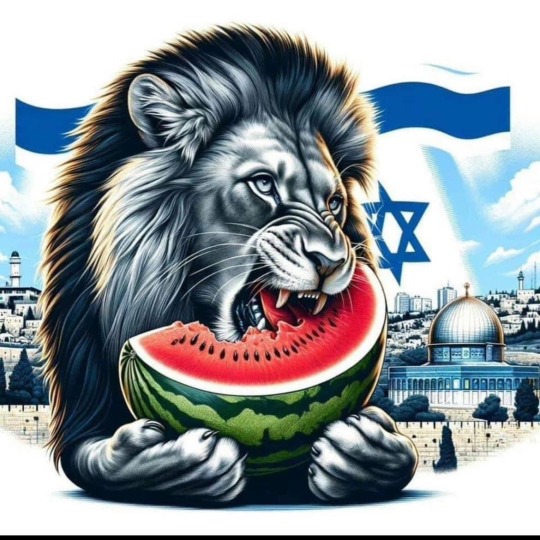
#lion of judah#israel#secular-jew#jewish#judaism#israeli#jerusalem#diaspora#secular jew#secularjew#islam#watermellon#Hamas#Isis#hezbollah#muslim brotherhood#al asqa brigades#al-qassam brigades#gaza#gaza war#Gazan#hamas war crimes
9 notes
·
View notes
Text
The year 2023 has been regarded the deadliest year for Palestinians since the 1948 war (also knows as the Nakba, which means Catastrophe in Arabic).
During the Nakba war about 250 Palestinian villages faced the fate of being demolished (some to the point of not existing on the map anymore) and their residents were forcibly displaced.
Today in Gaza, the numbers of the martyred and the injured are increasing every single day and yet the whole wide world is watching from afar, as if the Palestinian life is cheap or not worthy of speaking out for…
Don’t repeat the mistake made in 1948, because the damage done by the Nakba will never be forgotten and Palestine will never recover from it, but today it’s 2024 and you have a voice and you can use it to change something, and you have the ability to make your governments not repeat that same mistake once again 76 years later.
So use that voice and maximize your abilities, talents and the resources that you have to let the whole entire world know about what is happening in order for the whole world to rise and revolt against the ongoing Nakba against not only Palestinians, but also every oppressed people in the world that faces a horrible fate due to colonialism and white supremacy.
#palestine#free gaza#free palestine 🇵🇸#from the river to the sea palestine will be free#gaza#palestina#gazaunderfire#gaza strip#save gaza#gazaunderattack#stop palestinian genocide#palestinian lives matter#gazan genocide#gaza under attack#stand with gaza#gaza genocide#war on gaza#stand with palestine#pal#save palestine#long live palestine#end the genocide#end the apartheid#end the war#end the siege#end the occupation#ceasfire now#ceasefire#stop the genocide#stop the occupation
5K notes
·
View notes
Text
I’ve never seen anything like the press conference from the Palestinian workers at Al-Ahli Baptist Hospital in Gaza. They’re literally addressing the world surrounded by bodies on the ground. One is holding the corpse of a baby. I hope these images haunt every Zionist till the day they die.
#sometimes as a Palestinian you feel like you get used to seeing Palestinian death#in the homeland - in the diaspora - in our refugee camps - amongst family - everywhere#but you don’t. I cannot imagine the pain of gazan Palestinians. it is unfathomable#the world should be begging on their knees for the forgiveness of Palestinians in Gaza#palestine#free palestine
7K notes
·
View notes
Text
MAJOR UPDATE
Very important update from our friend @moatazart! Please read!!!
Moataz, Mariam, and Maria are SO close to having enough money to rebuild their lives in Egypt! Their paperwork is started and they are preparing for the dangerous journey south. However, the processing fees were extremely high, and consumed all of the money they had set aside for living expenses in Egypt. The goal is now to raise enough money for basic necessities!
If you can give even just a few dollars, it would be an immense help! If every one of our followers gave just $2, or if even half of our followers gave just $4, Moataz’s family would meet their goal!
HERE IS THE DONATION LINK!!! You can also click the link below
PLEASE keep up the momentum! Let’s help this family escape genocide!
Thank you all so much❤️
#north gaza#gaza#gaza genocide#gaza strip#gaza under attack#free gaza#from the river to the sea palestine will be free#palestinian genocide#gaza under bombardment#gaza update#gaza under fire#gaza under siege#gaza under genocide#save north gaza#save palestine#save gaza#stop gaza genocide#stop israel#free palestine#فلسطين#فلسطین#غزة#غزة تحت القصف#libre palestina#gazan genocide#moataz abu sakran#aid for north gaza#aid for palestine#aid for gaza#gaza aid
5K notes
·
View notes
Text
AID REQUEST FROM GAZA:


HELP LAMA AND HER FAMILY EVACUATE RAFAH.
— If you have some savings, why not spare $5/$10 to help Palestinians to safety!
— If 3,400 people donated $5, Lama and her family can meet their goal!
— Donating is super easy, especially if you have Apple/Google Pay!
— Reblogs and interactions help massively!
#palestine#aid for palestine#aid request#mutual aid#care for gaza#help gazans#aid for palestinians#how to help#donate today#donations#charity
1K notes
·
View notes